
Prepare yourself for another season
of provocative performance art at The Warhol. 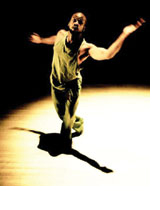 Marc Bamuthi Joseph Marc Bamuthi Joseph
The Spoken World
Saturday, January 15
A lauded spoken-word artist, slam poet, and choreographer,
Marc Bamuthi Joseph commands the stage and sways the
audience with his sharp, urgent, and elegant verse,
passionate dancing, and stunning transformations. Co-presented
with the African American Cultural Center of Greater
Pittsburgh.
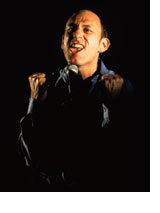 David Cale David Cale
A Likely Story
Saturday, February 5
All hell breaks loose as a married woman considers
making Viagra brownies to seduce her neighbor;
a wife’s
poodle obsession gets out of hand; and two straight
actors who loathe each other are cast as gay lovers
in a TV movie. Solo performance artist David Cale’s
tragically funny new show about people in the throws
of change comes to The Warhol fresh from its Off-Broadway
run.
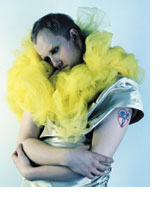 Antony and the Johnsons Antony and the Johnsons
An Evening with Antony and the Johnsons
Saturday, February 26
Fusing lush and dramatic chamber pop sounds with
a torch-song cabaret sensibility, Antony and the Johnsons
have risen to critical acclaim, recently participating
in the 2004 Whitney Biennial. Accompanied by the adept
and highly emotive performance art/chamber music ensemble
the Johnsons, Antony, an androgynous diva with a sweet
yet mournful
tenor, sings an unearthly blues.
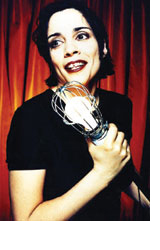 Marga Gomez Marga Gomez
Marga Gomez’s
Intimate Details
Saturday, March 12
With devastating one-liners, fabulous characterizations,
and a pinch of smut, Marga Gomez is an openly gay Latina
performance
artist and stand-up comedian who’s been described
as “hilariously trenchant in detailing a
host of contemporary gay experiences and ethos...
ferocious, biting, and riotous... intensely political,
but never strident."
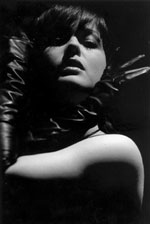 Nicole Blackman Nicole Blackman
Courtesan Tales
Friday, April 15, 7 p.m. – midnight
Saturday, April 16, 7 p.m. – midnight
Sunday, April 17, 3 – 8 p.m.
(Performances are by appointment only. Each performance
is for one person at a time
and is approximately 10
minutes long.)
Performance artist
Nicole Blackman presents her acclaimed and unique Courtesan
Tales, a series of lush tales
for the senses performed privately for one blindfolded
audience member at a time. Blending fairy tales, lapdances,
and haunted house stories,
the tales are romantic, mysterious, erotic, chilling,
and nostalgic.
Funding for The Warhol's
performing arts programming was provided by the
James H. Beal Fund, Jack and Tally
McKee Memorial Fund, and Samuel and Carrie Arnold Weinhaus
Memorial Fund of The Pittsburgh Foundation.
Photo Exhibition Prompts Visitors To Reflect on Tough
Issues
Inconvenient
Evidence: Iraqi Prison Photographs
from Abu Ghraib

Photo: Terry Clark
As
an artist, Andy Warhol took risks and challenged perceived
boundaries. His work, from 1960s paintings
of race riots to interpretations of the JFK assassination,
also consistently reflected the issues and images
of his time.
In this spirit, and in its own effort
to be a forum
for dialogue around contemporary subjects, The
Andy Warhol Museum has organized Inconvenient Evidence:
Iraqi Prison Photographs from Abu Ghraib, a small
exhibition
that focuses on the amateur photographs of human
rights abuses that recently emerged from Abu Ghraib
prison
in Iraq. The exhibition, which opened in September
to unprecedented media coverage, looks at the extraordinary
impact these
and other shocking images from Iraq have had on the
public opinion of the U.S. war in that country. The
simple presentation—computer print outs and newspaper
headlines pinned to the gallery walls—prompts
visitors to look at the images and ask tough questions.
“
History has the luxury of being in the past, so
that events and actions which were considered
dastardly
in their own time might now pass as neutral or
normal, ” says
The Warhol’s Director, Thomas Sokolowski. “This
exhibition exists in the powerful present and doesn’t
allow time for repose or sanctuary. The Abu Ghraib
images are stubborn facts that will not go away.
I am grateful when visual imagery can provide us
with
a tool that might help us as human beings find
resolution when no other path seems possible.”
The
photographs from Abu Ghraib prison were distributed
widely on the Internet and in the media, and
much like the pages of a newspaper, The Warhol has
presented
written commentary and reflection on the exhibition
as a series of “Op-Eds” that have been
gathered from diverse community members. Responses
from museum visitors also play a key part of the
exhibition, with comments ranging from expressions
of anger and
shock, to inner reflection and shame.
“
Thank you for your courage in showing these
pictures,” one
visitor writes in the gallery comment book. “As
much as it hurts me to look at them, it is
a pain that must be dealt with in order to
learn.” Another
visitor writes, “What these images, right
or wrong, do is force a mirror into the collective
consciousness.”
A special poetry program
related to Inconvenient Evidence will be
held on November 19 in partnership
with Cave
Canem, an African American poets organization.
Details can be found at www.warhol.org. The
exhibition will
be on view through November 28.
Inconvenient
Evidence: Iraqi Prison Photographs from Abu Ghraib has
been organized in partnership with
the International Center for Photography
in New York, where
it is on view simultaneously.
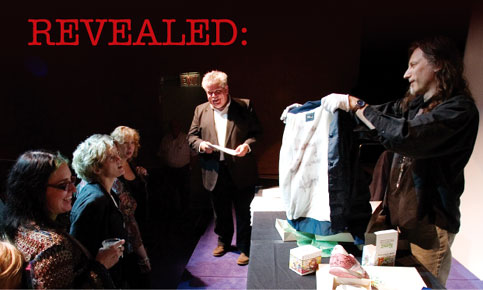
The
contents of one of Warhol’s
famous cardboard boxes were uncovered for the first
time at the opening of Andy Warhol’s
Time Capsules in October.
Cardboard boxes lined the walls and more
than 500 guests mingled in the galleries on October
2 to celebrate the opening of The Warhol’s newest
exhibition, Andy Warhol’s Time Capsules.
WQED’s
beloved historian and documentarian, Rick Sebak, hosted
the evening’s much-anticipated highlight, the
opening of a new Time Capsule. The theater was packed
to see Assistant Archivist Matt Wrbican and Assistant
Director for Collections and Research John Smith don
white gloves and open a lightweight Time Capsule labeled
by Warhol, “
Miss Piggy and Halston.”
The very pop-culture
contents, likely from the early 1980s, included a
Miss Piggy doll, matching Miss Piggy
and Kermit the Frog coffee mugs, Muppet-themed clothing,
and a pair of pink Muppet Ked sneakers (size 6) signed, “To
Andy, Love Halston.” All the items were in their
original boxes and most were signed by Warhol’s
good friend, fashion designer Halston. Although we
can’t know for sure, it appears Halston gave
Warhol the items as a bit of a birthday joke. Warhol,
being the packrat that he was, kept them along with
the more than 3,000 objects and ephemera now on view
throughout the museum.
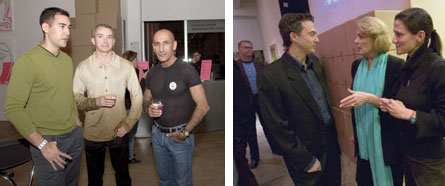
Photos:
Terry Clark
| Levi Zimmerman, David
Regel, and Richard Parsakian |
Jeff King, Alice Snyder, and Jen
Flanagan |
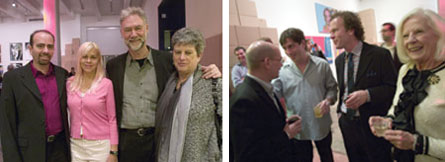
Photos: Terry Clark
| Gerald Hartnett,
Morgan Hartnett, Terry Smith, and Tina Smith |
John
Smith, Dutch MacDonald, Tim McVay, and Mary McVay |
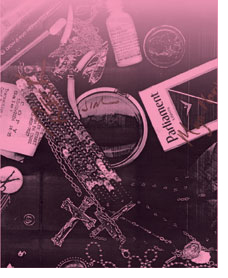 The Art of Collecting The Art of Collecting
Andy Warhol's Time Capsules encourage visitors
to explore their own tendencies to collect.
Some
people collect PEZ candy dispensers. Others
go for snow domes or coins—or like Andy
Warhol, anything from cookie jars to recordings
of his
Factory friends.
“
Everyone collects,” says Jessica Gogan,
The Andy Warhol Museum’s assistant director
for education and interpretation. “You
collect whether you know it or not—whether
it’s dust bunnies
or the piling of shoes in your closet.”
In
conjunction with the Andy Warhol’s Time
Capsules exhibition, Gogan’s department
is creating displays throughout the museum
that relate to different aspects
of collecting. The idea is to consider our
innate tendency to gather in relation to the
Time Capsules and Warhol’s
propensity to document—or collect—in
his artistic practice.
On the Underground level
of the museum, Warhol’s
habits are being examined in comparison with
local contemporary artists who collect junk,
detritus,
and ephemera to create
or inspire their own artwork. On the 5th floor,
visitors are encouraged to become part of the
exhibition by
emptying the contents of their pockets, bag,
or purse onto a photocopier
and creating an image of those items to add
to an ever-changing display.
In addition, every
Saturday and Sunday during the Time Capsules
exhibition, visitors to the
Weekend
Factory
(noon-4 p.m.) will be invited to explore Warhol’s
passion for collecting by creating a living
time capsule for 2004. Visitors of all ages
will have
the opportunity
to interact with Warhol through the website,
Friendster; vote for the top personalities
of 2004; silkscreen
some of the most memorable images of the year;
and more.
The overall goal of these projects
and displays, says Gogan, is to help patrons
find ways to “deepen
the art experience.”
Back to Contents |